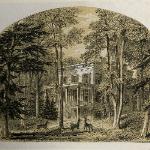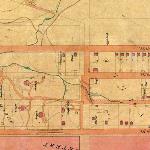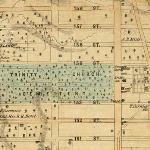 | ||||
Audubon House: 1852
(click to enlarge)
 | ||||
 | ||||
After wandering for some hours,
I turned into a rustic road which led directly down towards the river. A noble forest was planted on the one side of it, and on the other vast grain fields lay laughing in the sun...my walk soon brought a secluded country house into view...
Parke Godwin
Homes of American Authors
1842
It consisted of forty-four acres, all heavily wooded, and at that time was almost as remote from the city as a lodge in the Catskills.
Rufus Rockwell Wilson
New York Old and New
1902
Sixty-five years ago the upper part of Manhattan Island was still wood-land, as wild almost as the Southern savannahs, or the unpeopled prairies of the West...into this quiet and beautiful land in search of a retired home wandered Audubon, the naturalist, one of the great men of the world.
M. E. Audubon
Audubon's Granddaughter
New York Times
April 30, 1905
But, the labor of writing his Ornithological Biographies and of over-seeing the printing of the plates of his great work had for some years confined him to cities, and with the completion of the publication of The Birds of America, he felt that he must have a home in the country.
George Bird Grinnell
Audubon Park
1927
Introduction
Begin your walk at Broadway and 157th Street, in a small triangular park that is now officially named the Ilka Tanya Pagan Park. Locals still call it Pigeon Park, for reasons apparent even to the first-time visitor. Standing amidst apartment buildings and shops, you may have difficulty imagining the dense forests that Native Americans once hunted and that Dutch settlers later lumbered to build their Harlem stockades, the wildlife that thrived here, or – most difficult to imagine – the tranquility.
The Audubon Park story began in 1842, when John James Audubon, the naturalist, painter and woodsman, bought about fourteen acres here in northern Manhattan and built a sprawling house by the Hudson, where he lived until his death in 1851. Audubon called his estate Minnie's Land in honor of his wife, Lucy, whom he and his two sons called Minnie, a Scottish endearment for mother. In Audubon’s day, the streets that you see around you were nothing but parallel lines drawn on a map. A stream ran past this spot on its way down the hill to join the Hudson, just about where 157th Street is now. Rocky outcroppings and dense stands of oak, elm, and hemlocks covered the slope and here at the crest of the hill, deer roamed freely.
After Audubon’s death, Lucy and her sons, Victor and John Woodhouse, finding themselves land-rich and cash-poor, built and rented several houses on their property. Then, when their financial situation continued to deteriorate, they began parceling their property into lots, which they sold. By the 1860s, both Victor and John Woodhouse had died and Minnies Land had passed out of the Audubon family’s hands, though Lucy continued to live nearby for another decade.
In the 1850s, Minnies Land residents had begun calling their neighborhood – which by then was a small enclave of about ten large homes – Audubon Park, a name that appeared in print as early as 1854 and on city maps by the 1860s. Audubon Park remained secluded, resisting external change, until the early 1900s when – with Riverside Drive encroaching upon the western side and the subway urging New York up town here on the eastern side – the buccolic landscape yielded to a cityscape that looked much like what you see today.
Within just a few years, from 1909 to 1911, the apartment buildings around you had replaced the mansions, drives, and gardens and the name Audubon Park had disappeared from city maps and eventually from the city’s collective memory..
Your virtual walk will lead your through today’s Audubon Park where you will examine architectural treasures that date from the early 1900s, experience history, and find some clues that will help you capture Audubon Park's colorful past.
Audubon Park:
approx. 1860
(click to enlarge)
Minnie's Land Map: 1851
(click to enlarge)
Continue your walk . . .
Funded by the Audubon Park Alliance


